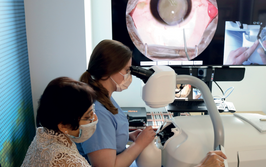
A Shared Vision
Five eye care experts present their views on the growing need for effective collaboration between ophthalmologists and optometrists – and practitioners from other disciplines
Alun Evans | | 20 min read | Interview
The relationship between optometrists and ophthalmologists – and the line separating the two – has often been fuzzy or even contentious. Back in the 1940s, for example, it was illegal for optometrists to use both diagnostic and therapeutic drugs in the US. It wasn’t until 1971 – when Rhode Island passed the bill H 1517A, making it the first state to allow optometrists to use drugs for diagnostic purposes – that this attitude gradually began to change and the line between optometry and ophthalmology began to blur.
Since then, there has been plenty of well-publicized opposition to expanding the scope of optometric privilege – and collaborative care between the two professions appears to be in a state of flux. This is especially true in the US, where the situation is complicated further by varying state legislature.
To explore the latest thinking in this space and to learn how “shared care” models benefit optometrists, ophthalmologists, and their patients, The Ophthalmologist reached out to five advocates of effective collaboration.
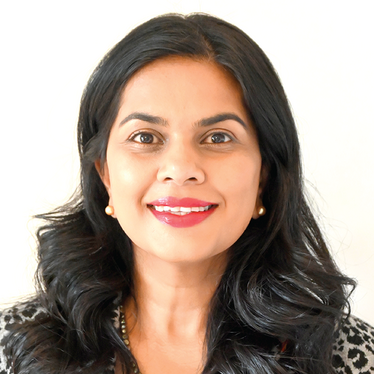
Credit: Headshot supplied by Mariya Moosajee
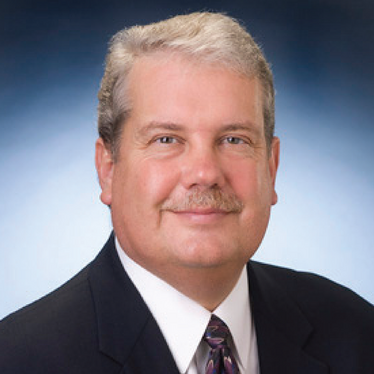
Credit: Headshot supplied by Kevin Waltz
What does multidisciplinary team working look like in your country?
Mariya Moosajee (UK): Ever since I entered medicine, the UK has always been incredibly strong in terms of multidisciplinary team (MDT) working – both in the clinical and research setting. At my own pediatric genetic eye disease clinic at Moorfields Eye Hospital, we begin each clinic with a MDT meeting where we discuss all patients attending and plan their management through our clinic and beyond. The core team consists of a consultant pediatrician specializing in neurodisability, a genetic counselor, an extended role orthoptist, a low vision optometrist, a family support officer, an imaging technician, a nurse, and myself. Together we can facilitate an excellent care pathway that covers most – if not all – of their needs in one visit, removing the need for several appointments.
Similarly, if I look at the research team I have built at UCL Institute of Ophthalmology and The Francis Crick Institute, it is composed of scientists (some specializing in stem cell biology, genetics, biostatistics, or animal models), ophthalmologists, psychologists, optometrists, and orthoptists. Each specialist brings their own skills and expertise, but we work as a team, drawing on each other’s strengths but also ensuring joint working so that new transferrable skills are learnt and a common “lab” language is spoken. This approach allows the whole team to contribute to discussions and provide different perspectives that push our research forwards in a diverse and open forum.
Kevin Waltz (US): In the US, optometry is typically a key part of ophthalmic research because there are many different layers to responsibilities and duties, and so optometric education fits very well with that. However, in the Spanish-speaking world, optometry is more what we would think of as a high-level technician in the English-speaking world. For instance, in Guatemala getting a degree in optometry takes six years. So it’s quite an extensive degree in some parts of the world, but, nevertheless, although they practice independently they’re not expected to have the same level of knowledge and responsibility as in the English-speaking world.
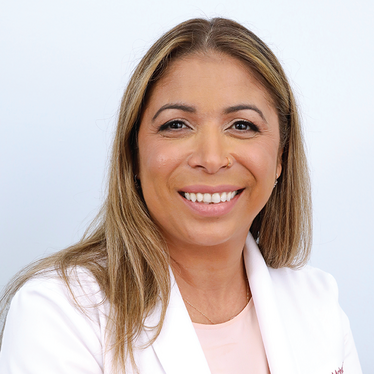
Credit: Headshot supplied by Glenda Aleman-Moheeputh
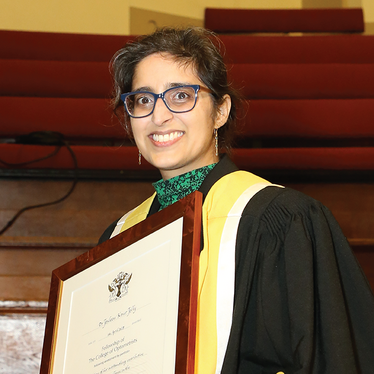
Credit: Headshot supplied by Jasleen Jolly
Glenda Aleman-Moheeputh (US): I think it is better now than it was years ago. We’re definitely moving in the direction of elevating or encouraging more collaborative care for patients, but I still think there’s a significant gap.
Jasleen Jolly (UK): I’ve moved in several workspaces, both research and clinical, and I’ve noticed quite a lot of variability. In some places, it’s very integrated and it works like a dream; in others, there seems to be a lot of resistance to that integration. And it’s not just from the older generation; that resistance can be propagated through the training that’s needed to allow multidisciplinary clinics and services to happen. But we need it to happen. There’s so much demand for these clinical services that, if we don’t have the multidisciplinary way of working, the NHS is basically going to collapse.
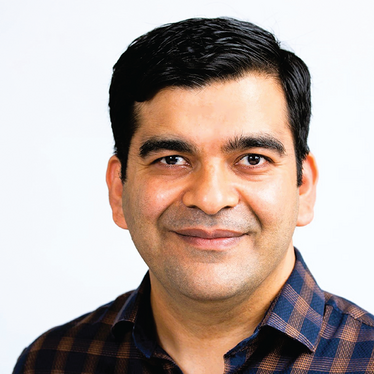
Credit: Headshot supplied by Himal Kandel
Himal Kandel (Australia): Most Australian ophthalmologists have good working relationships with optometrists in their local area. They work together toward a common goal of improving patient outcomes. With the growing burden of vision and eye disease, ophthalmologists and optometrists are finding new ways of working together. For example, the integration of telemedicine technologies presents a promising avenue for expanding access to eye care in remote areas via collaboration between ophthalmologists and optometrists.
How has the climate for optometry–ophthalmology collaboration changed over the course of your career?
Moosajee: I have always had the pleasure of working alongside optometrists in the hospital setting. I have seen them take more of an extended role consulting patients and providing care under the supervision of a consultant. I personally like to empower all of our allied healthcare professionals to gain more skills and confidence through training to expand their remit. This provides variation and allows them to remain stimulated. I work closely with optometrists who are active both clinically and in the research environment, and they strike a good balance. Our collaborations compliment my approach, which can be very focused on the disease, reminding me to consider how we can better support patients in their daily lives, for example through digital assistive technology and low vision aids.
Kandel: Throughout my career, I have worked in several optometry and ophthalmology settings and observed various levels of collaboration. Ophthalmologists and optometrists are both driven by the shared goal of ensuring every patient has access to the highest quality eye care.
The nature of this collaboration varies across settings, reflecting unique challenges and solutions. In places like Nepal and Kenya, for instance, where ophthalmology programs predated optometry programs, the latter became crucial in meeting the demand for eye care, especially given the low number of ophthalmologists. In Eritrea, where there was an acute shortage of ophthalmologists and a high burden of cataracts, the prolonged time required to train ophthalmologists prompted the training of ophthalmic nurses in cataract surgery, showcasing an innovative approach to address the pressing need for eye care.
In developed countries, such as the UK and Australia, new models of care are being considered for ophthalmologists and optometrists to work together to meet the growing demand for eye care. Globally, with the aging population, the need for eye care services is increasing and collaboration between ophthalmologists and optometrists is more crucial than ever before.
Jolly: Optometrists have access to extra qualifications now, which allow their advanced skills to be formally recognized. There is also funding for emergency eye care in the community, which has reduced the number of referrals into casualty departments in hospitals. So GPs now refer to these qualified optometrists in the community rather than going straight to the hospital. There’s a lot of formal shared care schemes. There are also optometrists working in advanced roles within hospital clinics alongside the ophthalmologists.
I think where the ties could be stronger are in the clinical trials arena. And not just with ophthalmologists, but with any specialty where they’re using vision outcomes (for example, psychiatry or neurology). In clinical trials, the only people who make the decisions are the ophthalmologists, but they may not have as deep an understanding of visual function measurement as optometrists. And that’s a problem because inappropriate outcome measures can lead to clinical trials failing to reach their pre-specified outcome measure.
Waltz: There has been a huge change. I graduated from optometry school in the US in 1981, and I graduated from my ophthalmology residency in 1991. In 1981, not all states allowed the use of medication for eye exams – so dilating drops and things like that were not legal for optometrists to use in some states. Nowadays, all states will allow drops for diagnostic purposes, and most states allow drops for therapeutic purposes – glaucoma, antibiotics, and so on.
A decade or so ago, a few states started allowing some surgical privileges. Now, there’s a big difference between administering drops and surgery, and so there has been a much slower evolution; nevertheless, it is now there in the landscape.
So I’d say there’s been a profound difference over the last 40 years.
The challenge is that optometry has grown and evolved into more competition with ophthalmology. And that’s problematic. Optometry grows and competes against itself, but it also grows and competes against ophthalmology; ophthalmologists grow and compete against each other, but also against optometry…
Aleman-Moheeputh: It has changed significantly. I think at this point we are seeing more collaborative care between optometrists and ophthalmologists. One of the reasons for that higher collaborative care is, if we look at it from the optometrist’s point of view, we have applied and extended the scope of practice, so that has allowed us to do a little bit more medical optometry, which gives a perfect environment to allow for more collaborative care.
Optometrists have an expanded scope of practice in some states where they can do more medical procedures because the laws allow for it. There is definitely less collaborative care in states where the scope of practice for optometry is not as high or as wide as those other states. So it varies from state to state, but I would say that overall, nationally, it is moving more in the direction of collaborative care.
What are the main advantages of closer collaboration?
Kandel: Collaboration between ophthalmologists and optometrists offers several significant advantages across clinical care and research domains. In terms of clinical care, the combined expertise and resources of these two groups – with appropriate task shifting and task sharing – result in increased outpatient capacity and improved timeliness of follow-up, leading to reduced waiting times for patients seeking eye care services. This collaborative approach enhances the overall efficiency of the healthcare system, ensuring that individuals receive timely and comprehensive treatment.
In the realm of research, mutual support from both professions is crucial. By capitalizing on the capacity of both ophthalmologists and optometrists, collaborative efforts can drive innovation, advance medical knowledge, and contribute to the development of more effective and tailored approaches to eye care. The synergy between these two professions not only benefits individual patients, but also strengthens the broader healthcare community by fostering a more integrated and interdisciplinary approach to addressing the complexities of eye health.
Jolly: Our skills are very complementary – we’re not doing the same thing so there’s no threat. We need each other to work effectively, and that will ultimately support the NHS in reducing waiting lists, enhancing patient care, training junior doctors and other health care workers so then we can have a bigger role in actually designing future treatments.
In the clinical trials space, if optometrists were more involved in the decision making process, if we were treated as equal partners, if we were employed as equal experts to the ophthalmologists by pharmaceutical companies, more trials would use better outcome measures. And if outcome measures were better funded as a proper research area, which is largely run by optometry and vision scientists, then we’d have greater success of translation from lab to bedside. Literally millions of dollars are currently going to waste because drugs – even gene therapies – are being deemed as not working when they do; they’re just not being measured properly to prove that they work.
Waltz: My experience has been that each profession is best when they are practicing close to the edge of the margin of their privileges. If you have an ophthalmologist who’s prescribing reading glasses, they’re probably not paying much attention for the most part, because it’s not going to hurt anybody and they don’t consider that a challenge in their world. However, if you’re talking about cataract surgery, their anxiety is up, their caution is up, and they’re really towing the line and doing the best job they know how.
What’s nice is to have as many team members as possible practicing close to the edge of their authority and their license, because then everybody’s optimally practicing. It’s kind of like on a speedboat – when you are moving along on a speedboat and you get going fast enough, it gets up on a plane above the water and it becomes much smoother and more efficient. I believe that professionals are very much the same – when they’re practicing at the edge of their privileges, they go faster, they’re smoother, they’re better, and they’re more responsible.
Aleman-Moheeputh: I think by far the biggest advantage is to the patient. Collaborative care can lead to significant improvements in the treatment of the patient. It also translates to a better life for that patient because it results in fewer visits between different offices and the number of doctors they need to see for their eye care needs.
Could you provide an example of how closer collaboration between ophthalmologists and optometrists has benefited patients?
Moosajee: A great example is Gene Vision (www.gene.vision) – a fully accessible web resource focused on genetic eye conditions. It exists not only for healthcare professionals but also for all patients and public users. It was created as an educational tool for healthcare professionals as we entered into the era of genomic medicine, so that they could gain knowledge of rare inherited eye diseases and understand how to manage patients, including genetic testing with whole genome sequencing and access the latest information on clinical trials and related research. Gene Vision underwent usability testing with real-world end-users and professional digital accessibility consultants to ensure both deaf and visually impaired users could access the site fully.
A brilliant optometrist named Kishan Devraj approached me and suggested I could make Gene Vision even more accessible if we created a “chatbot” in conjunction with Amazon’s Alexa. The chatbot is now linked to the website. Kishan is so passionate about digital health, he has now started a PhD in my research group, building an app that can monitor patient’s real-time behavior. He is using this passive data to correlate the digital signals with the patient’s clinical phenotype. Ultimately, this will allow us to monitor disease progression, changes in vision, and associated parameters – like mental health – so that we can see patients in a timely manner, provide intervention, and apply a more holistic approach to care.
Kandel:The Save Sight Registries, such as the Save Sight Keratoconus Registry and Save Sight Dry Eye Registry, showcase the collaborative efforts by ophthalmologists and optometrists to improve outcomes in patients with eye diseases. These registries are international, web-based patient databases for tracking and improving the natural history of eye diseases and treatment outcomes. The keratoconus registry has two modules – one each for ophthalmologists and optometrists – and a linked referral web-based system allowing optometrists to share patient outcomes with ophthalmologists, and vice versa. All practitioners can track their patients with enhanced graphical displays of the patient’s disease journey and benchmark outcomes with other practitioners in the system. The registry system has promoted seamless patient care for ophthalmological and optometric management of keratoconus. In Australia, ophthalmologists get CPD points from the Royal Australian and New Zealand College of Ophthalmologists (RANZCO) and optometrists from Optometry Australia (OA) for using the registry in their clinical practice.
In Nepal, during my undergraduate studies at B.P. Koirala Lions Centre for Ophthalmic Studies (BPKLCOS), Institute of Medicine, I experienced first-hand the advantages of a collaborative environment. In outpatient departments, optometry students, optometrists, ophthalmology resident doctors, and ophthalmologists worked together. The BPKLCOS is one of the most reputed ophthalmic training centers in Nepal. The collaborative setting provided an excellent teaching/learning environment. I am sure every ophthalmologist and optometrist trained at BPKLCOS appreciates the benefits of this collaborative model for learning and delivering quality eye care services.
Jolly: When I was working in Oxford at the diabetic eye service, optometrists were involved at every level. They were involved as graders for when the images came in; then I set up the clinic for the people whose images weren’t readable. We also had ophthalmologists and optometrists working together in the diabetic clinic for patients who failed the grading and had to be seen in the ophthalmology clinics.
Waltz: I’ll tell you my favorite co-management story with an optometrist from outside of my practice. I took care of a patient who wanted to have presbyopia correcting lenses. He was referred to me, and so I did his surgery, the surgery went great, but the patient was not happy. His job requires good vision, and although our measurements said that he had good vision, he said he didn’t so was unhappy. Eventually he called me up on the phone and threatened bodily harm. I called up his co-managing optometrist and explained to him what happened, and he said, “Oh no, he’s doing drugs again.” The optometrist was friends with the sheriff in town, so he called him to say that the patient was threatening an ophthalmologist. The patient wasn’t taken to jail, he just had an adult conversation with law enforcement telling him what he couldn’t do. I got on famously with that optometrist for the rest of my career. That’s a level of co-management that you rarely get to, but it shows what happens when you have different levels of involvement in the process!
Aleman-Moheeputh: We are very lucky in my community because we have developed a very strong network of ophthalmologists and optometrists. To help to bridge that gap between them, and to encourage more collaborative care, we have founded a local group – which we hope to go national, and then international – called Women in Eye Care (WE). The whole purpose of WE is to encourage and facilitate more collaborative care among optometrists and ophthalmologists, and women in the industry as well.
We had an event recently for ophthalmologists and optometrists to socialize and get to know each other, so that if a patient requires, say, a retinal surgeon, we can recommend a retinal surgeon that we know. Personally, I feel more comfortable referring my patients to a specialist once I get to know them; if they seem like a good person, I’m going to be more likely to refer patients to them than somebody just off the directory.

Credit: The Ophthalmologist
Is there still a rift between the two professions?
Moosajee: In my particular field of genetic eye disease, there are no rifts that I am aware of. As with most healthcare professionals – including general ophthalmologists, GPs, and other allied groups – a lot more education is required in terms of genomics and how to manage patients with rare genetic eye diseases. I think we need to reach out and provide more teaching to optometrists on how to manage these patients who present to their practices, so they know how and when to refer them to specialist centers. In the future, there is scope for shared care with patients in the community and this will certainly bring the two professions closer together.
Jolly: In some spheres, yes. In some areas, there is still resistance to letting optometrists in – especially in the clinical trials space, as I mentioned earlier. Allowing medics to make all the decisions here can lead to unnecessary failure.
Waltz: Both professions raise money to be spent in the political arena to attack each other, so officially there’s a rift! But on a day-to-day basis with the people you work with? There’s not much of a rift. We are all trying to do our best to take care of patients and get along very well together.
Aleman-Moheeputh: There’s still a significant gap. We are making progress, but our progress is not nearly as fast as it needs to be. Just last year, we fought a battle here in Florida, where there was resistance to calling optometrists “physicians.” That was a rule promoted or sponsored by ophthalmology to try to keep optometrists from expanding our scope of practice.
Unfortunately, there is still this significant gap and initiatives like Women in Eyecare are necessary to bring awareness to this issue, because the only person that is suffering is the patient. At the end of the day, the patient is the one that suffers the consequences because they’re the ones that are not getting proper care due to this lack of collaboration.
The demand for healthcare is getting higher and higher every day, and there’s just not enough ophthalmologists to meet the patient demand. Ophthalmologists are going to have to do something, because the only way they will be able to provide eye care to all the patients that are in need is by allowing optometrists to deal more with primary care, and having ophthalmologists deal with the specialties.
How might closer collaboration between the two professions be facilitated; for example, by government or other associated bodies?
Kandel: Closer collaboration between ophthalmologists and optometrists to improve the outcomes of their patients can be facilitated through a structured framework with shared care arrangements. The frameworks should clearly distinguish between ophthalmology-led and optometry-led care and services, including referral protocols. Establishing structured collaborative frameworks helps streamline the process of how patients receive care, ensuring a more coordinated and efficient approach. Shared care arrangements should foster a patient-centric approach, allowing for a smoother and more effective distribution of responsibilities based on the availability of resources.
Task shifting and task sharing, adaptable to different settings, can optimize the use of available skills and expertise. Recognizing the role of optometrists as the primary eye care service providers in most places allows ophthalmologists to concentrate on patients with serious eye conditions or else those in need of surgical interventions, promoting a more strategic and collaborative approach to eye care delivery.
Cultivating better professional relationships is key, and local meetings provide valuable platforms for optometrists and ophthalmologists to share experiences and expertise. Government and associated bodies can play a pivotal role in endorsing and implementing these collaborative strategies to enhance patient outcomes and optimize the use of available resources.
Jolly: I think regulators need to recognize that if vision function is being used then you need to have vision function experts – which means optometrists and/or vision scientists – on the team. Pharma and clinical trials teams that are led by medics also need to recognize that and bring those people on, not just as team members, but as decision-makers and experts.
A multifactorial change needs to happen, and I think maybe our professional bodies could do more to recognize this, but the regulators definitely need to do more to recognize this.
We need a mindshift across the board, because recently there have been a spate of high-impact clinical trials failures – particularly in the gene therapy and rare disease space. Because of these failures many companies seem to be pulling out of ophthalmology. So if we don’t get this in order, a lot of patients are going to lose access to potential therapies and I think that’s a massive shame.
I think this is really a crunch point for ophthalmology, and I think that’s where we can make the biggest impact change right now.
Waltz: It’s very likely – based on my 40 years’ experience in the profession – that we’re going to evolve to a place that’s better than where we’re at today. I believe we’re going to develop a system that’s going to make more sense than it does today. There’s going to be some give and take along the way, and there’ll be some winners and losers, but we will have a system that works for the optometrist and for the ophthalmologist, and for the patients.
Ophthalmologists, generally speaking, like to operate, and it’s been shown that the more an ophthalmologist operates, the fewer complications they have. An ideal system would see relatively few people doing a lot of surgeries and a sophisticated support system around that. So, an optometrist doing a low number of surgeries is not beneficial for anybody. What you want is an ophthalmologist working their butt off in surgery doing a great job. And then an optometrist who can support that, doing medical ophthalmology to help the ophthalmologists so they have more time to concentrate on surgery so that there’s a better outcome for the patients, and there’s better economics for the whole system.
Is there anything you would like to add?
Kandel: By working together, optometrists and ophthalmologists can effectively address the diverse needs and wide spectrum of eye-related conditions, ultimately leading to improved patient care. These collaborative efforts contribute to enhanced quality, coordination, and efficiency in the delivery of eye care services. Embracing an integrated model, where both optometrists and ophthalmologists play complementary roles, emerges as the optimal approach.
Aleman-Moheeputh: It’s really important that we leave our differences aside and work towards encouraging collaborative care. If we depend on the government or a third party to come in and fix it, it is going to take longer. I think if each of us does our part, and puts more effort into referring our patients, into managing our patients, providing the best care, and collaborating with our colleagues, we can make a huge change and have a significant impact in the field.
About the interviewees:
Mariya Moosajee is Professor of Molecular Ophthalmology at UCL Institute of Ophthalmology, Group Leader of Ocular Genomics and Therapeutics at the Francis Crick Institute, and Consultant Ophthalmologist specializing in Genetic Eye Disease and Head of the Genetics Service at Moorfields Eye Hospital NHS Foundation Trust, London, UK.
Himal Kandel is Kornhauser Research Fellow (Postdoctoral Research Fellow), Save Sight Institute, Sydney Medical School, Faculty of Medicine and Health, the University of Sydney, Sydney, Australia.
Jasleen Jolly is Associate Professor, The Vision and Eye Research Institute, Anglia Ruskin University, and Honorary Research Fellow, Wellcome Centre for Integrative Neuroimaging, University of Oxford, Oxford, UK. Director of Jolly Vision Science, www.jollyvisionscience.com.
Kevin Waltz is President of Ophthalmic Research Consultants, and Chair, Board of Directors for Central American Eye Clinics.
Glenda Aleman-Moheeputh is President and CEO, OK Love Myopia Control Experts, Florida, US.
Coming from a creative writing background, I have a great interest in fusing original, narrative-driven concepts with informative, educational content. Working at The Ophthalmologist allows me to connect with the great minds working in the field of contemporary eye care, and explore the human element involved in their scientific breakthroughs.
